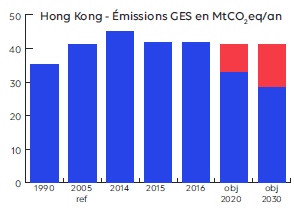Hong Kong - Gasification of the electricity mix
Territorial assessment of climate action
2018
Association Climate Chance (Climate Chance)
Since 2015, the Climate Chance Association has been involved in the mobilization in the fight against climate change. It is the only international association that proposes to bring together on an equal footing all non-state actors recognized by the UN. In order to strengthen their action and to give credibility to the climate stabilization scenarios, the Climate Chance Association launched in 2018 a Global Observatory of Non-State Climate Action, which aims to explain the evolution of greenhouse gas emissions, by crossing national public policies, with sectoral dynamics, private actors’ strategies, local public policies and actions undertaken by local actors. In order to analyse the coherence of local public policies, Climat Chance proposes an assessment of « territorial mobilisations » through selected examples of cities and regions. Here, Hong Kong.
Hong Kong’s ambition is to reduce its carbon intensity by 50% by 2020, and by 65-70% by 2030 compared to 2005. This is equivalent to an absolute reduction in emissions of 20% in 2020, and between 26% and 36% by 2030 (Climate Plan 2030+). The 7.5% drop in GHG emissions in 2015 (from 45 to 41.7 MtCO2eq) comes after an almost constant increase since 1990. This drop is even more marked per capita (-8.4% : the lowest since 2004 with 5.7 tCO2eq/capita) and per GDP point (-9.7% : the lowest since 1990 with 0.017 kg CO2eq/HK Dollar GDP). However, an equivalent decrease each year would be necessary for HK to reach its 2020 target.
ELECTRICITY PRODUCTION: THE MAIN LEVER FOR REDUCING EMISSIONS.

Electricity production, 90% of which is used to power buildings, is by far the main source of emissions with 66% in 2016, ahead of transport (18%) and waste (5.9%). The decrease in 2015 is entirely due to the replacement of several coal-fired generation units by natural gas, resulting in a 10% drop in emissions from electricity production (Gov HK 2016). By 2020, HK intends to double the share of electricity generated from natural gas (27% in 2015) to meet growing demand, and conversely to halve the share from coal (50% in 2015). Its 2030 action plan also calls for 25% non-fossil fuel electricity, but the few structures in the region that are powered by renewable energy represent less than one percent of the Hong Kong mix (e.g. the water treatment plant in Siu Ho Wan Bay, 25% of which is powered by solar energy). The new contract established in 2018 with the two electricity companies for the next 15 years (CLP Power and HK Electric) introduces a feed-in tariff partly financed by the sale of « renewable energy certificates ». (CERs) to companies that wish to voluntarily reduce their emissions. This system should make it possible to achieve 3-4% renewables in the electricity mix by 2030. This non-fossil share therefore corresponds mainly to nuclear electricity imported from China, with which HK signed an agreement in 1994 covering 25% of its needs and recently renewed until 2034.
DEMAND MANAGEMENT AND ELECTRIFICATION OF PUBLIC TRANSPORT
In addition to the code imposing energy efficiency standards on new buildings and renovation projects, the HK region introduced a mandatory « MEELS » labelling system in 2008, gradually extended to all household appliances, air-conditioning systems etc. available on the market (phase 2 in 2015 and phase 3 in 2018). Its updating in 2015 should lead to annual savings of 300 million kWh. In addition, the region is asking companies on its territory to carry out and publish their carbon balance sheet on the Carbon Footprint Repository platform, on which 83 companies are already present (Gov HK 2018). With 90% of journeys already made using public transport in 2015, the challenge for the Hong Kong government is to improve the energy efficiency of its trains and public buses (Gov HK 2017). In 2011, it has therefore made available the HK$300 million (€33 million) Pilot Green Transport Fund, open to public transport and goods vehicle operators to equip themselves with more efficient vehicles (electric, hybrid, innovations for trains and boats). The 22nd round of project selection in May 2018 brought the number of subsidized projects to 124 for a total funding of HK$134 million, almost half of the available funds.